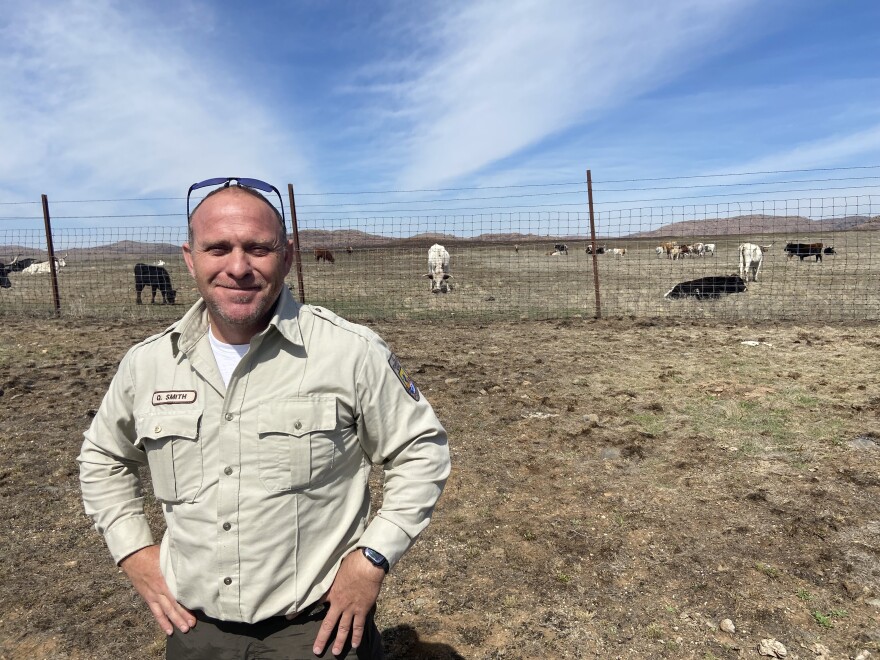I’m Rachel Hopkin from KGOU’s How Curious, the series dedicated to stories from around Oklahoma.
The Texas Longhorn is so strongly associated with, er, Texas – not least because of UT’s famous football team which is nicknamed after the bovine – that it came as news to me to learn that the Texas Longhorn breed actually owes its survival in large part to Oklahoma.

The Mollie Spencer Farm is an educational establishment and animal sanctuary in Yukon, OK. When I visited a few months back, I was shown around by Emma Newberry-Davis and Milo Bardwell. Among the latest animals to take up residence there were a mother and son pair of Texas Longhorns called Marianne and Rusty. They had arrived in the autumn of 2022, at which point, Marianne was pregnant again. Then, in January 2023, she gave birth to a beautiful Texas Longhorn bull calf who was named Spencer. Soon after, KGOU received a press release announcing the happy event. While it was delightful to hear of Spencer's arrival in and of itself, it was something else in the press release that caught our attention at KGOU. Emma explains:
"When we got the Longhorns, we got their Longhorn paperwork and through that we learned that Marianne had been part of the Wichita Wildlife Refuge herd. And then, we realized the reason that the Wichita herd exists is because the Longhorn was on the verge of going extinct. I believe it was the US government decided to make a herd, take them to the Refuge, and essentially try to preserve the breed."
Again, like most people, the first place that comes to my mind when thinking Longhorn is Texas. It’s one of the most recognized symbols of the state. Yet while the fact that Oklahoma played a crucial role in saving the breed from extinction may not be that widely known generally, it is a familiar fact in Longhorn circles. For example, the website of the Texas Longhorn Breeders Association of America confirms that the Wichita herd was the first created with the sole purpose of their conservation.
I therefore decided to visit the refuge itself. On arrival, I met with Quinton Smith who works there and he took me out in the hope of finding some of their Texas Longhorn herd. Quinton said that they were usually pretty easy to find, but added the caveat the place is “a wildlife refuge. We don’t keep them caged up. They’re free to roam the entire 60,000 acres of the refuge and go find the best grass and the best grazing they can and use it.”

Quinton told me that the Refuge receives around two million people a year, many of whom also go off looking Longhorns, and shared a note of caution:
"They’re not as docile as one might think . I worked with cattle at home. And when I got to the refuge, I thought that working with the Longhorn would be the same as working with any other breed. One day, we were sorting cows and calves and I jumped out and I wasn’t on the ground probably 10 second and this momma cow ran me up and out of the pen. And all the guys standing around – they’re like 'Quinton. You cannot do that.' So they’ve got a higher temperament than some of the other breeds of cattle you’ve been with."
A few minutes later, we struck gold: a herd numbering around 40-50, including many calves. We stayed well back so as not to disturb them and Quinton drew my attention to the their unique appearance:
"You see this black and white cow nursing this red and white calf. The pattern of speckles on them are about the same but the colors are totally different. The variations in the colors of the Texas Longhorn have been really neat to me. You see other breeds and all the cattle are red or all the cattle are black, or white. You just don’t get that with the Texas Longhorns. You get that menagerie of colors and break ups and spots and stripes and solids."
To learn more about how this Longhorn herd came to be here, and about the Refuge itself, I went to its Visitor Center. From its introductory film, I learned that the place was founded in 1901, when President McKinley signed a proclamation setting aside 60,000 acres of what was then known as the OK Indian territory to serve as a forest and game preserve. Now called the Wichita Mountains Wildlife Refuge, it ranks as one of the oldest preserves on earth.
Donna Phillips is one of the Refuge’s longest serving volunteers. She told me that the Texas Longhorn descended from cattle which were brought to the north American continent in 1521 from Spain. The cattle were arrived in Mexico and moved up into south Texas. That original Texas herd consisted of 200 head and was the foundation for the Texas Longhorn which had emerged as a distinct breed by the mid 1800s and numbered in the millions.
Dan McDonald is a Wildlife Biologist at the Refuge and explained that part of reason that the breed thrived is because it is remarkably hardy: “A Longhorn is pretty well self-sufficient. The more European type breeds need more hands-on … vaccinations; you might need to help them pull calves as they give birth. A Longhorn – you could put one out it a parking lot and it would do just fine."
It was because Longhorns were both so plentiful and robust that they became the primary stock of the cattle drives were common during the 19th century, many of which were more than 1000 miles long. It’s estimated that 10 million had been driven out of Texas by 1889. But that’s not why the Longhorn was almost extinct a few decades later. Instead it was because they were being so actively interbred with other types of cattle to produce a meatier animal, thereby diffusing the characteristics of a true to type Longhorn.
By the mid 1920s, the plight of the Longhorn was well recognized. A 1927 New York Times article describes the breed’s doom as being sealed. Thankfully that was the same year that Longhorn conservation got under way at the Refuge. A ranger at the Refuge called Earl Drummond is credited with the original idea. Once the 69th congress approved that $3000 be set aside to cover the costs of bringing a herd to the Wichita Mountains, things really got moving.
Donna and Dan told me more. Apparently, Refuge personnel were sent to Texas where they surveyed around 30,000 head and they selected the 30 that showed the strongest, purest characteristic of the original Longhorn. In terms of the qualities they were seeking, these included the colors; their overall body characteristics – such as large bones, long back legs, little shorter forelegs, wide between the eyes, short neck, and long head. Dan said that they “even looked at the udders to make sure that they were large enough." Their horn characteristics were also important. Away from the Refuge, many Texas Longhorns today are bred to have the longest, straightest horns possible. But the Wichita men were looking for particular kinds of curved formations.

Once the foundation herd had been selected, it was brought to the Refuge. The animals were branded and a controlled program of breeding began. Donna told me that by rotation and record keeping they "eventually over time bred out all impurities” - i.e. any remaining traces of interbreeding with other types – “and we have the pure true pure breed Texas Longhorn now."
The size of the herd is controlled to ensure that there are never more cattle than the Refuge’s grassland can accommodate. Each year a selection is auctioned off. I was told that some buyers come to secure a little part of history, the WR (for Wichita Refuge) brand, and as true a pure Longhorn as possible. Others simply for the quality of Longhorn beef which - although it might be “very lean," Dan told me, is also apparently “quite tasty."

Which brings this story full circle back to the Mollie Spencer farm and its Wichita Refuge Longhorns descendants. Their original mother and son pair had belonged to an Oklahoma beef farmer who purchased WR cattle. But over time he found himself unable to continue in his line of work. Apparently, once he’d seen the affection the cattle had for each other, their intelligence, and how they cared for family and friends, he said: “I don’t see how you can send them off to be slaughtered." With the help of an organization called Farm Sanctuary, all 60 of his herd were placed in new and forever homes across the country, including the Mollie Spencer Farm in Yukon. Marianne, Rusty, and now Spencer, are blessed.
How Curious is a production of KGOU Public Radio. It’s produced Rachel Hopkin. The editor Logan Layden and David Graey composed the theme music.
Please don’t forget, if you have an Oklahoma-related question or subject which you’d like us to cover in How Curious, please email curious@kgou.org.
USEFUL LINKS





